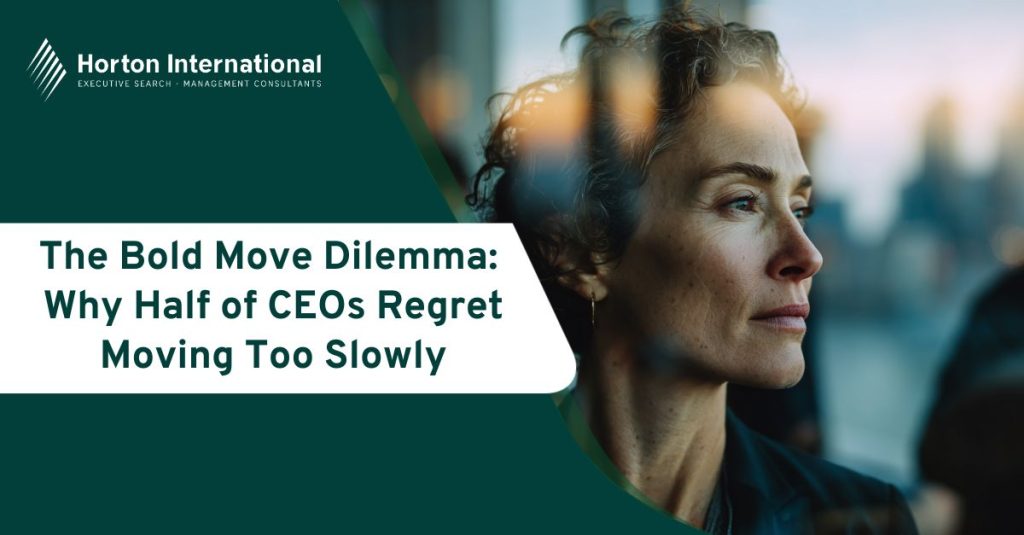More than half of former CEOs identify the same career-defining mistake: moving too slowly. This finding from a Boston Consulting Group survey of 70 senior executives reveals that hesitation is more dangerous than bold action. CEOs who initiated transformations within their first two years delivered markedly higher total shareholder returns than those who delayed, yet economic uncertainty continues pushing leaders towards caution precisely when decisiveness matters most.
This data challenges conventional executive wisdom. Across 7,000 CEO tenures worldwide, BCG found that delayed action costs organisations measurable shareholder value. The paradox is stark: whilst betting big feels riskiest during uncertainty, the evidence shows that failing to act decisively poses the greater threat to long-term success.
Why Caution Becomes Costly
In part, this hesitation epidemic stems from how leaders perceive risk itself. A further BCG survey revealed that 80% of senior leaders view risk in predominantly negative or neutral terms. This defensive mindset blinds organisations to upside potential, causing CEOs to miss first-mover advantages whilst competitors seize them:
- Global disruption amplifies the cost of delay. America’s protectionist pivot, China’s economic transition, and the confident rise of the Global South are redrawing trade corridors.
- The race for technological supremacy in artificial intelligence and quantum computing intensifies daily.
- Climate imperatives reshape supply chains.
Against this backdrop, strategic paralysis becomes an existential risk, making adaptive executive leadership not merely valuable but essential.
The Transformation Imperative
Successful executive leadership transformation requires a dual mindset: sustaining operational excellence whilst pursuing strategic investments and long-term growth narratives. Most leaders struggle with this balance, pinned between quarterly pressures and multi-year horizons.
Transformational CEO recruitment focuses on identifying leaders who balance this tension naturally. Effective executives don’t abandon operational rigour, rather, they ensure immediate demands never eclipse strategic imperatives. This dexterity separates high-performing CEOs from those who later regret their caution.
Is it innate then? Maybe to a degree – but any executive can use these four approaches to creating ‘uncertainty advantage’
1. Quantify Upside and the Cost of Inaction
Traditional risk frameworks emphasise downside protection, obscuring opportunity costs in the process. Decisive leadership requires reframing strategic questions to surface hidden potential. Successful CEOs ask: “What if our strategy delivers better-than-expected results?” and “What actions would we regret not taking?” This exploratory thinking reveals early adopter advantages that cautious competitors miss.
2. Balance the Operator and Investor Perspectives
Senior leaders must carve out time for big-picture reflection, examining future possibilities with executive teams. CEO succession planning increasingly prioritises candidates demonstrating this ability to move fluidly between immediate execution and long-horizon thinking. With government interventions in markets increasing six-fold over the past decade, leaders need foresight to navigate regulatory complexity and identify strategic opportunities amidst policy volatility.
3. Escape the Echo Chamber
Companies consistently examining external environments achieve 5% higher success rates in growth transformations compared to inward-focused firms. This requires systematic engagement with diverse viewpoints, from frontline teams to external contrarians. Executive search for change leaders must identify individuals comfortable with cognitive diversity and intellectual challenge.
4. Audit for Bias, Blind Spots, and Boldness
Self-awareness can be a CEO’s most powerful tool. Reducing cognitive and group biases in decision-making, enables executives to follow intuition whilst safely pursuing strategic risk-taking through critical examination of alternatives. Leaders need systematic approaches to identifying their own blind spots before markets expose them.
From Vision to Velocity
Decisive leadership isn’t merely about speed; it’s about direction. The most effective leaders don’t merely respond to disruption: they design the future. Yet McKinsey research reveals only 22% of employees believe their leaders possess a future vision. This gap reflects not just missed inspiration but failed execution.
A compelling vision serves as the strategic force fuelling innovation, aligning teams, and sharpening operational clarity. In organisations that endure and evolve, vision becomes embedded in systems, behaviours, and even rituals. Companies outperforming competitors do so not by reacting faster but by aligning sooner, anchoring every decision and investment to a clearly defined future state.
When vision is operationalised and woven into workflows, and performance systems, it:
- transforms organisational capability
- drives sustainable growth through faster resource allocation and consistent decision-making
- strengthens talent retention by demonstrating that individual work matters within a broader mission
- elevates customer experience as frontline teams make better decisions aligned to company values.
Leadership experts emphasise that when employees become co-authors of vision, they transform into champions of the mission. This democratisation of strategic intent creates what high-performing organisations recognise as their most durable competitive advantage: not just efficient execution, but intentional alignment at every level.
The Recruitment Challenge
These findings carry profound implications for executive search. Organisations require leaders combining analytical rigour with entrepreneurial boldness and operational discipline with strategic imagination. The ideal candidate doesn’t merely tolerate ambiguity: they love it, seeing in volatility the raw material for competitive advantage.
This demands assessing not just past performance but decision-making velocity, comfort with calculated risk, and ability to maintain conviction under uncertainty. It requires evaluating how candidates balance stakeholder perspectives, navigate geopolitical complexity, and translate vision into executable strategy. Traditional executive search criteria are insufficient when half of CEOs ultimately regret their own hesitation.
Adaptive executive leadership means more than responding to change. It means anticipating it, shaping it, and positioning organisations to benefit from it.
Choosing Risk Over Regret
The evidence is unequivocal for today’s CEOs—caution costs more than courage. For boards and search firms seeking competitive advantage through transformational leadership, the path forward demands not just strategic thinking but strategic action.
In an era where more than half of CEOs regret moving too slowly, the boldest move may be this: selecting leaders unafraid to make bold moves themselves. Because whilst markets forgive many mistakes, they rarely forgive hesitation. And in the time it takes to achieve consensus, first-mover advantage disappears, competitive positioning erodes, and shareholder value evaporates. The cost of moving too slowly is the distance between what your organisation achieved and what it could have become.







